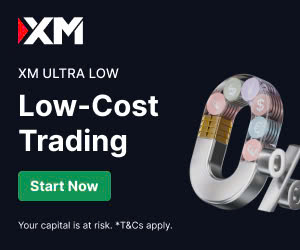
9 minute read
XM vs Pepperstone: A Comprehensive Comparison
Choosing the right forex broker is a critical decision for traders, whether you're a beginner or a seasoned professional. XM vs Pepperstone are two of the most prominent names in the forex and CFD trading industry, each offering unique features, competitive pricing, and robust trading platforms. In this comprehensive comparison, we’ll dive deep into the key aspects of XM vs Pepperstone, including their regulation, trading platforms, fees, account types, leverage, customer support, and educational resources. By the end, you’ll have a clear understanding of which broker suits your trading style and goals.

💥 Trade with XM now: Open An Account or Visit Brokers 🏆
Overview of XM vs Pepperstone
XM: A Global Leader for All Traders
Founded in 2009, XM has grown into a globally recognized forex and CFD broker, serving over 3.5 million clients across 190+ countries. Known for its beginner-friendly approach, low minimum deposit, and extensive range of trading instruments, XM is regulated by top-tier authorities like the Australian Securities and Investments Commission (ASIC), the Cyprus Securities and Exchange Commission (CySEC), and the International Financial Services Commission (IFSC) in Belize. XM’s commitment to transparency and client satisfaction has earned it a strong reputation in the industry.
Pepperstone: The Choice for Advanced Traders
Established in 2010 in Australia, Pepperstone is renowned for its low spreads, fast execution, and advanced trading platforms. With a focus on high-volume and algorithmic traders, Pepperstone caters to professionals while still being accessible to beginners. The broker is regulated by multiple reputable bodies, including ASIC, the UK’s Financial Conduct Authority (FCA), CySEC, and the Dubai Financial Services Authority (DFSA). Pepperstone’s cutting-edge technology and competitive pricing make it a favorite among scalpers and day traders.
Regulation and Safety
XM: Strong Regulatory Framework
XM operates under strict regulatory oversight, ensuring client funds are secure. Its licenses include:
· ASIC (Australia): A top-tier regulator known for stringent compliance requirements.
· CySEC (Cyprus): Offers deposit protection up to €20,000 for EU clients.
· IFSC (Belize): Provides flexibility for higher leverage options.
XM segregates client funds from company funds and offers negative balance protection, safeguarding traders from losses exceeding their account balance. Its 15+ years of operation and clean regulatory track record make it a trustworthy choice.
Pepperstone: Global Trust and Compliance
Pepperstone boasts an impressive regulatory portfolio, with licenses from:
· ASIC (Australia): Ensures robust oversight and client fund protection.
· FCA (UK): Provides deposit protection up to £85,000 for UK clients.
· CySEC (Cyprus): Aligns with EU regulations.
· DFSA (UAE), BaFin (Germany), CMA (Kenya), SCB (Bahamas): Expands its global reach.
Like XM, Pepperstone segregates client funds and offers negative balance protection (with some limitations under certain jurisdictions). Its Trust Score of 95 from ForexBrokers.com reflects its high reliability, slightly ahead of XM’s score of 88.
Verdict: Both brokers are highly secure, but Pepperstone edges out slightly due to its broader range of top-tier licenses and higher trust score.
Trading Platforms
XM: MetaTrader Focus
XM offers the industry-standard MetaTrader 4 (MT4) and MetaTrader 5 (MT5) platforms, which are widely praised for their:
· Advanced charting tools and technical indicators.
· Support for automated trading via Expert Advisors (EAs).
· Availability across desktop, web, and mobile devices.
XM also provides a proprietary WebTrader platform for browser-based trading, making it accessible for traders who prefer not to download software. The platforms are user-friendly, making them ideal for beginners and experienced traders alike.
Pepperstone: Diverse and Advanced Options
Pepperstone supports a broader range of platforms, including:
· MetaTrader 4 (MT4) and MetaTrader 5 (MT5): Similar to XM, with full EA support.
· cTrader: A favorite among advanced traders for its intuitive interface, fast execution, and advanced order types.
· TradingView: Offers powerful charting and social trading features, appealing to modern traders.
Pepperstone’s cTrader platform is particularly suited for algorithmic traders, with features like Capitalise AI for code-free automation. Its platforms are optimized for low latency, with execution speeds as low as 30ms.
Verdict: Pepperstone takes the lead with its diverse platform offerings, especially for advanced traders who prefer cTrader or TradingView. XM is better for those who stick to MetaTrader.
Fees and Spreads
XM: Competitive but Account-Dependent
XM offers three main account types:
· Micro Account: Ideal for beginners, with a $5 minimum deposit and spreads starting at 1 pip.
· Standard Account: Spreads from 0.6 pips, no commission, and a $5 minimum deposit.
· XM Zero Account: Ultra-low spreads from 0 pips, with a $3.50 commission per lot per side.
XM’s spreads are competitive but slightly higher than Pepperstone’s during volatile market conditions. The broker does not charge deposit or withdrawal fees, and its fee structure is transparent. However, the XM Zero account’s commissions make it less cost-effective for low-volume traders.
Pepperstone: Industry-Leading Low Spreads
Pepperstone provides two primary account types:
· Standard Account: Commission-free, with spreads starting at 0.6 pips (average 1.1 pips for EUR/USD).
· Razor Account: Spreads from 0 pips, with a commission of $3.76 per lot per side (MT4/MT5) or $6 per lot round trip (cTrader).
Pepperstone’s Razor account is highly competitive, with an all-in cost of 0.80 pips for EUR/USD, making it one of the cheapest options for high-volume traders. The Active Trader program offers spread rebates for large trading volumes. However, spreads on cryptocurrencies like Bitcoin are above industry averages.
Verdict: Pepperstone wins for its lower spreads and cost-effective Razor account, especially for scalpers and high-volume traders. XM is more affordable for beginners with smaller accounts.
Account Types and Minimum Deposits
XM: Beginner-Friendly Flexibility
XM’s low minimum deposit of $5 across its Micro, Standard, and XM Zero accounts makes it accessible to traders with limited capital. It also offers:
· Micro Account: Trades in micro-lots (0.0001 lots), perfect for risk-averse beginners.
· Standard Account: Balances affordability and flexibility.
· XM Zero Account: Caters to professionals with tighter spreads.
· Shares Account: For trading stock CFDs, with commissions.
XM’s Islamic (swap-free) accounts are available for traders following Sharia law.
Pepperstone: Professional Focus
Pepperstone recommends a $200 minimum deposit (though none is strictly required), which is higher than XM but still reasonable. Its account types include:
· Standard Account: Commission-free, suitable for beginners.
· Razor Account: Low spreads with commissions, ideal for scalpers and algorithmic traders.
· Spread Betting Account: Available for UK clients only.
· Islamic Account: Swap-free for Sharia-compliant trading.
Verdict: XM is more beginner-friendly with its $5 minimum deposit and micro-lot trading. Pepperstone suits traders with larger budgets and professional needs.

💥 Trade with XM now: Open An Account or Visit Brokers 🏆
Leverage and Trading Instruments
XM: High Leverage and Broad Asset Range
XM offers leverage up to 1:1000 (depending on the regulatory jurisdiction), which is among the highest in the industry. This appeals to risk-tolerant traders but increases the potential for significant losses. XM provides over 1,000 trading instruments, including:
· Forex (55+ currency pairs)
· Stock CFDs (600+ companies)
· Commodities, indices, precious metals, energies
· Cryptocurrencies (e.g., Bitcoin, Ethereum)
XM’s extensive asset range makes it ideal for portfolio diversification.
Pepperstone: Competitive Leverage and Diverse Markets
Pepperstone offers leverage up to 1:500 (ASIC-regulated) or 1:30 (FCA/CySEC-regulated), which is lower than XM but still competitive. It provides over 1,200 instruments, including:
· Forex (61+ currency pairs)
· Indices, commodities, cryptocurrencies
· Share CFDs (64 major stocks)
· ETFs and spread betting (UK clients only)
Pepperstone’s cryptocurrency trading is unavailable for UK retail traders due to FCA restrictions.
Verdict: XM offers higher leverage and a wider range of stock CFDs, while Pepperstone provides more instruments overall and unique offerings like ETFs.
Customer Support
XM: Multilingual and Accessible
XM provides 24/5 customer support via live chat, phone, and email, with support in over 30 languages. However, some users report slow response times and occasional irrelevant answers, which can be frustrating.
Pepperstone: Professional and Responsive
Pepperstone also offers 24/5 support through live chat, phone, and email. Its support team is highly rated for professionalism and quick resolution of issues, earning awards for premium service.
Verdict: Pepperstone has the edge for its responsive and professional support, while XM excels in multilingual accessibility.
Educational Resources
XM: Beginner-Focused Learning
XM shines in its educational offerings, particularly for beginners. Its resources include:
· Webinars and live trading sessions
· Video tutorials and market analysis
· Articles covering forex basics and advanced strategies
XM’s comprehensive learning center is ideal for new traders looking to build a strong foundation.
Pepperstone: Advanced Trader Focus
Pepperstone provides a robust library of educational content, including:
· Webinars and archived tutorials
· Articles on technical analysis and trading strategies
· Trading guides and an economic calendar
While Pepperstone’s resources are valuable, they cater more to experienced traders, with less emphasis on beginner-level content.
Verdict: XM is better for beginners due to its extensive and accessible educational tools. Pepperstone suits advanced traders seeking in-depth analysis.
Deposit and Withdrawal Processes
XM: Fast and Cost-Free
XM offers a variety of payment methods, including bank transfers, credit/debit cards, Skrill, Neteller, and e-wallets. Deposits are instant, and withdrawals are processed quickly (often within 24 hours) using its AI-driven back-office system. XM covers all deposit and withdrawal fees, which is a significant advantage.
Pepperstone: Efficient but Limited Options
Pepperstone supports bank transfers, credit/debit cards, PayPal, Skrill, Neteller, and local payment methods like M-Pesa. Deposits are free, and withdrawals are processed same-day if requested before 12:00 AEST/AEDT. However, Pepperstone offers fewer withdrawal methods than XM vs does not support cryptocurrency transactions.
Verdict: XM has a slight edge due to its broader range of payment methods and fee-free transactions.
Which Broker is Right for You?
Choose XM if:
· You’re a beginner with limited capital (low $5 minimum deposit).
· You prefer MetaTrader platforms and a user-friendly experience.
· You want high leverage (up to 1:1000) and a wide range of stock CFDs.
· You value extensive educational resources and multilingual support.
Choose Pepperstone if:
· You’re an experienced trader or scalper seeking low spreads and fast execution.
· You want access to advanced platforms like cTrader or TradingView.
· You prioritize top-tier regulation and a professional trading environment.
· You trade high volumes and can benefit from the Razor account’s pricing.
Final Thoughts
Both XM vs Pepperstone are exceptional forex brokers with strong regulatory frameworks, competitive fees, and reliable platforms. XM stands out for its beginner-friendly features, low entry barriers, and extensive educational resources, making it ideal for new traders or those with smaller budgets. Pepperstone, on the other hand, excels in providing low spreads, advanced platforms, and a professional trading environment, catering to experienced and high-volume traders.
Ultimately, the choice between XM vs Pepperstone depends on your trading goals, experience level, and preferences. We recommend testing both brokers’ demo accounts to experience their platforms and trading conditions firsthand. By aligning your needs with the strengths of each broker, you’ll be well-equipped to make an informed decision for your trading journey in 2025.
💥 Note: To enjoy the benefits of the partner code, such as trading fee rebates, you need to register with XM through this link: Open An Account or Visit Brokers 🏆
Read more:




